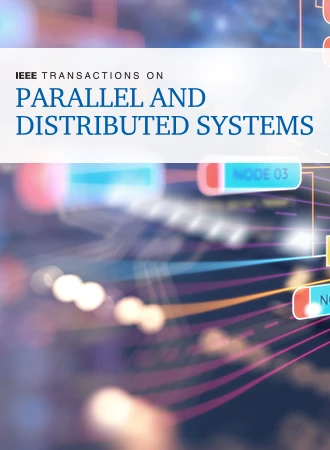Towards Efficient Verifiable Cloud Storage and Distribution for Large-Scale Data Streaming
IF 5.6
2区 计算机科学
Q1 COMPUTER SCIENCE, THEORY & METHODS
IEEE Transactions on Parallel and Distributed Systems
Pub Date : 2025-01-07
DOI:10.1109/TPDS.2025.3526642
引用次数: 0
Abstract
Data streaming is an ordered sequence of data continuously generated over time, whose dynamic scale is hard to be predicated in advance. Since the traditional integrity verification primitives are not qualified to check the integrity of the retrieved data and the outsourced database in streaming setting, some specific schemes were proposed by adopting the tree-like authentication structure or the combination of signature and accumulator. However, these schemes are not optimal for the owner. The main concerns can be generalized as how to reduce the size of the authentication information to be less than the scale of the data streaming, and enable the resource-constrained owner to check the data integrity without using challenge. To address the problems, we intend to find a new approach to design the scheme by exploiting the novel technique called decentralized vector commitment (DVC). Towards this goal, we first propose a key exposure-freeness chameleon vector commitment scheme, and then present the efficient DVC technique based on our key exposure-freeness chameleon vector commitment scheme. The scheme is finally constructed by leveraging the efficient DVC technique. Besides the integrity verification, our scheme is also sufficient to efficiently distribute the data to a user who is protected from receiving the stale data. To optimize the performance in concurrently retrieving multiple data, we introduce the batch query that reduces large amounts of communication and computation overheads. The security analysis and performance evaluation show that our solutions are secure and efficient.面向大规模数据流的高效可验证云存储和分发
数据流是一段时间内连续产生的有序数据序列,其动态规模难以提前预测。针对传统完整性验证原语在流环境下无法对检索数据和外包数据库进行完整性校验的问题,提出了采用树状认证结构或签名与累加器相结合的具体方案。然而,这些方案对业主来说并不是最优的。主要关注的问题可以概括为如何将身份验证信息的大小减小到小于数据流的规模,并使资源受限的所有者能够在不使用挑战的情况下检查数据的完整性。为了解决这些问题,我们打算通过利用称为分散向量承诺(DVC)的新技术来找到一种新的方法来设计方案。为此,我们首先提出了一种关键无曝光变色龙矢量承诺方案,然后在此基础上提出了高效的DVC技术。最后利用高效的DVC技术构建了该方案。除了完整性验证外,我们的方案还足以有效地将数据分发给用户,保护用户不接收过时的数据。为了优化并发检索多个数据的性能,我们引入了批量查询,它减少了大量的通信和计算开销。安全性分析和性能评估表明,我们的解决方案是安全高效的。
本文章由计算机程序翻译,如有差异,请以英文原文为准。
求助全文
约1分钟内获得全文
求助全文
来源期刊

IEEE Transactions on Parallel and Distributed Systems
工程技术-工程:电子与电气
CiteScore
11.00
自引率
9.40%
发文量
281
审稿时长
5.6 months
期刊介绍:
IEEE Transactions on Parallel and Distributed Systems (TPDS) is published monthly. It publishes a range of papers, comments on previously published papers, and survey articles that deal with the parallel and distributed systems research areas of current importance to our readers. Particular areas of interest include, but are not limited to:
a) Parallel and distributed algorithms, focusing on topics such as: models of computation; numerical, combinatorial, and data-intensive parallel algorithms, scalability of algorithms and data structures for parallel and distributed systems, communication and synchronization protocols, network algorithms, scheduling, and load balancing.
b) Applications of parallel and distributed computing, including computational and data-enabled science and engineering, big data applications, parallel crowd sourcing, large-scale social network analysis, management of big data, cloud and grid computing, scientific and biomedical applications, mobile computing, and cyber-physical systems.
c) Parallel and distributed architectures, including architectures for instruction-level and thread-level parallelism; design, analysis, implementation, fault resilience and performance measurements of multiple-processor systems; multicore processors, heterogeneous many-core systems; petascale and exascale systems designs; novel big data architectures; special purpose architectures, including graphics processors, signal processors, network processors, media accelerators, and other special purpose processors and accelerators; impact of technology on architecture; network and interconnect architectures; parallel I/O and storage systems; architecture of the memory hierarchy; power-efficient and green computing architectures; dependable architectures; and performance modeling and evaluation.
d) Parallel and distributed software, including parallel and multicore programming languages and compilers, runtime systems, operating systems, Internet computing and web services, resource management including green computing, middleware for grids, clouds, and data centers, libraries, performance modeling and evaluation, parallel programming paradigms, and programming environments and tools.
 求助内容:
求助内容: 应助结果提醒方式:
应助结果提醒方式:


